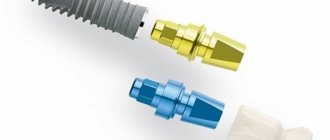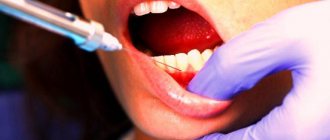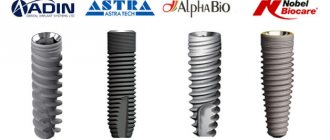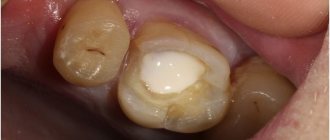Dental restoration is another popular niche in dentistry, which allows you to continue the life of a badly damaged natural tooth without prosthetics (and sometimes together with it). For this purpose, a pin is used - a special rod, which will be a new support for the destroyed tooth, and a complex tooth is built on it.
Tooth extension onto a pin
In most dental clinics, in the list of services you can find the column “Tooth restoration by extension (pin).” This procedure copes well with such tasks as correcting bites and correcting aesthetic tooth defects. Extension is a popular service, which is sometimes equated to artistic restoration.
Pins for teeth extension
Need for expansion
The question of the advisability of this operation can hardly be classified as controversial. With the exception of a number of contraindications (which will be discussed a little later in the corresponding section of this review), the decision to grow teeth turns out to be truly correct from both an aesthetic and functional point of view.
The technology currently used allows for prompt and high-quality restoration of worn teeth, as well as completely eliminating the consequences of chipping. And if for the rear, hidden from prying eyes, units of the dentition, the main parameters are reliability and practicality, then the front row, which is in plain sight, should also have excellent presentability. Fortunately, today all these problems are completely solvable.
For the restoration of primarily molars, a composite material is often used, which in its physical, safe and aesthetic properties is as close as possible to the natural original. As a result of the restoration, the incisors and molars are completely restored to their original natural shape and color.
What does the clinic guarantee?
It is clear that the dental clinic cannot guarantee the quality of the implant. However, it provides a guarantee for the successful completion of the operation. Typically, the duration of such a guarantee ranges from one to two years. It should be emphasized that the guarantee is given only for the installation of a titanium root.
Practice shows that the risk of implant rejection remains for two years after implantation. Apparently, this is why clinics give a two-year guarantee on their work. As for rejection, this often happens due to a violation of the implantation technology. However, there are cases when the patient’s body rejected the implant for no apparent reason.
Statistics show that the cause of inflammatory processes that occur in the first weeks or months after surgery is a medical error or simply the surgeon’s negligence.
The failure of the implant to take root most often occurs due to the surgeon’s lack of proper experience. An unsterile instrument, an error in choosing the type of implant, or rough drilling of the bone - all this can lead to rejection of the titanium root.
At the same time, if implant rejection occurs after three to five years, then this is not the fault of the dental surgeon. Practice shows that the patient himself is to blame for this; he did not fully follow the surgeon’s recommendations, and they are always given in the most detailed form. Also, later implant rejection can occur due to emerging diseases.
Unfortunately, obtaining compensation in the event of implant failure is very, very difficult, if not impossible.
Extension methods
If we talk about extension methods, there are two of them:
- straight,
- indirect.
The first allows you to restore the incisor during a one-time visit to the dentist. The composite material is applied over the dental crown. The use of this technique is possible only in the presence of minor damage.
As for the indirect option, specialized overlay materials are used for its implementation: veneers, crowns, as well as various inlays.
A specialist carrying out such restoration activities is obliged to find a solution that will be the most rational and the only correct one for each individual situation. The choice of technique depends, in particular, on the following parameters:
- root integrity,
- condition of the bone-jaw tissue,
- area of the dental crown,
- condition of the gum tissue.
Below we will discuss the most popular restoration methods, which include:
- filling,
- pins,
- tabs,
- veneers,
- photopolymers,
- photocomposites.
Sealing
This is the simplest answer to the question “how does teeth building happen?” This method is chosen when the patient’s bone tissue is practically intact. Most often, filling is used when the enamel is excessively thin, there are significant interdental spaces, and damage to the front teeth.
This method has not one advantage, but several. Firstly, thanks to the tandem of modern technologies and specialist skills, the result is very accurate. Secondly, the plastic composite used has many shades, among which you can choose a color scheme that is as close as possible to natural. Thirdly, the composite material has a high degree of adhesion, growing tightly and forming a single whole with bone tissue.
Extension on a pin
If the root is preserved, a pin is often used to carry out restoration work. The latter can have different shapes and sizes, which allows you to choose the most optimal option in strict accordance with the anatomical features of the patient’s oral cavity. Most often, this method of extension is used to eliminate chips on the front teeth.
Modern dentistry uses, as a rule, 4 types of pins:
- gutta-percha (flexible, but prone to rapid damage),
- carbon (has good strength characteristics and is relatively inexpensive),
- fiberglass (the most rational option for the restoration of front teeth),
- anchor (the strongest, most reliable and durable).
Tabs
In another way, this method of extension is called microprosthetics. Its essence lies in the use of specialized inlays, which in fact are individually made fillings.
If there is a carious cavity on the chewing part of the tooth, there is a high probability of empty cavities forming. Of course, in this case, you can also get by with regular filling. However, only an inlay can completely fill the cavity and also prevent changes in the bite.
Often, individual inlays are made of ceramic or porcelain. Such materials perfectly retain the original shade and do not lose other original characteristics, which, as has been said many times, is the most optimal combination.
Extensions using inlays are usually practiced in situations where most of the crown is chipped. If the area to be restored is invisible when smiling, an individual inlay can be made of metal, the prices of which are noticeably lower, and the practical properties are in no way inferior to ceramics and porcelain.
Veneers
We are talking about thin porcelain plates, the lining and fixation of which is carried out on the outer part of the tooth. This option is used for a variety of damage to the anterior units of the dentition.
As a result of using veneers, your smile becomes flawlessly even. Moreover, the material used usually lasts for about 10 years, without losing its original shade even with systematic smoking, as well as drinking coffee and all kinds of carbonated drinks that contain a coloring pigment.
However, veneers also have some disadvantages. Firstly, before installation, careful grinding of the tooth is required so that the latter does not protrude from the general row in the future. Secondly, due to the ideal proportions obtained as a result of such extensions, the naturalness of the smile is sometimes somewhat lost.
Photopolymer
The use of photopolymers is relevant in case of significant wear of the crown or extensive carious damage. To strengthen the result, during the process of filling the affected areas, the material used is exposed to ultraviolet radiation.
Important warning: if there is inflammation in the oral cavity, the use of photopolymers is contraindicated.
Composite
The main purpose of photocomposites is to eliminate cosmetic defects. The latter include cracks, chips, and other minor damage.
The material hardens under the influence of an ultraviolet lamp quite quickly, ultimately obtaining the required shape. One visit to the orthopedic dentist - and such a cosmetic issue is guaranteed to be resolved.
A few words about false advertising
Probably, each of you has come across advertisements about a 100% guarantee on dental implantation or about the lifetime service of dentures and crowns. The authors of such advertising are infinitely far from real dentistry. There simply cannot be any eternal guarantee, if only because no surgeon can guarantee this. No matter how hard the specialist tries, the decisive factor in the durability of the structure will still be the actual condition of the patient’s body.
A lifetime guarantee is indeed given, but not for the fact that the implant will not be rejected by the body, but only for its mechanical integrity.
Which restoration method to choose?
There is no clear answer here for obvious reasons. It all depends on the degree of damage that the crown and root have. If we talk about the direct method, it is as gentle as possible, since its implementation does not require first removing the nerves. The composite material is applied to the crown in layers. At the same time, the tooth is still “alive” and is able to perform its original functions.
It is not possible to use the indirect method without first removing the nerves. An orthopedist implants inlays and pins into the root canals of a tooth with a dead nerve, after which a layer-by-layer application of composite material is performed. If the patient has significant damage to the crown, this extension option is the only possible one.
Indications for installing a pin in a tooth
Only a dentist can determine the possibility of installing teeth on pins. The doctor must assess the patient’s health, check for allergic reactions, determine the degree of tooth destruction, calculate the likely load and take into account the thickness of the walls of the root canal. Therefore, the following indications exist for a crown on a pin:
There are also certain contraindications for this procedure:
- granuloma or root cyst;
- damage to the tooth root by caries;
- mobility of dental periodontium;
- the root canal is shallow;
- root penetration.
If the doctor has discovered contraindications to the installation of pins, then do not be upset. An experienced specialist will always select the optimal dental restoration procedure that is suitable specifically for your case.
Extension of various types of teeth
Depending on the type of teeth, the extension process may have some features. But since the most common techniques have already been discussed above, the focus in this section will be on the main problems, as well as the reasons for their occurrence.
Front
According to statistics, the front teeth are mechanically damaged quite often. As a result, chips, cracks and other defects form. It is also not uncommon for a fairly large fragment of a tooth to break off due to injury.
Another problem with the front teeth is abrasion. And if the patient has a direct bite, then such a problem becomes completely pathological.
Special types of abrasion include the so-called “horseshoe” abrasion, which is typical for those who like to chew seeds.
Extensions using composite materials will help solve all of the above problems, as well as eliminate gaps between teeth.
Chewable
The destruction of chewing teeth is also not uncommon. The main reason is caries (especially deep caries), as a result of the treatment of which significant cavities are formed, filled with filling materials.
The use of modern gentle techniques makes it possible to preserve the tooth root even in cases that were previously considered hopeless. As for the restoration of the coronal part, the most effective methods in this case are the installation of an inlay and a crown.
When preparation for veneers is not necessary
Composite veneering is a method in which a composite layer is applied to the tooth, layer by layer, each time drying it with light. This allows the dentist to adjust the thickness of the veneer, shape the cutting edge and shape. Thanks to layer-by-layer application, the tooth does not need to be turned, the surface is simply ground. In all other cases, the enamel is ground to different depths.
There is another type of overlay that does not require turning - these are lumineers. They are made from special material, only in the USA. You have to wait for delivery, and if 1 lumineer breaks, then you also have to wait until it is made and sent. The Russian analogue, ultranirs, does not need to wait long, but if you need to correct the shape of a tooth, you will still have to grind it down.
Thin veneers can correct only minor defects: lighten teeth a couple of tones, cover dim pigmentation, mask the gap between teeth.
This method has disadvantages:
- Even ultra-thin veneers without grinding enlarge teeth
. With small teeth this is not noticeable, but if the teeth are large, then they visually look too massive. - to correct the shape of a tooth without grinding.
- It is difficult
to smooth the transition of the veneer to the gum ; bacteria can accumulate there, causing caries.
Pros and cons of extensions
The objective advantages of artistic restoration include:
- safety (the method is suitable even for children),
- possibility of restoration even with significant chips,
- high degree of strength of the extended part,
- natural appearance.
As for the disadvantages, these include the comparative high cost. Despite the variety of methods and price categories, most often this procedure is not cheap.
Another disadvantage is that to ensure safe conditions for the restored area, it becomes necessary to wear a mouth guard during sleep.
Stages of implementation
At the first consultation, the oral cavity is examined and an x-ray is studied. In the absence of contraindications, the restoration process begins:
1. Both the type and method of pin installation are selected. The rod is selected taking into account the condition and type of dental unit (incisor, premolar, molar). The method of implantation is influenced by the integrity of the root.
2. The root canals are cleaned and expanded (by 2/3).
3. The rod is fixed, the canal is cemented.
4. Composite material is applied as a base for the crown.
5. The visible crown part of the tooth is installed. This can be a ready-made structure or layer-by-layer photopolymer. In the latter case, the material is applied in stages, fixing each layer with ultraviolet light.
6. The crown of the tooth is formed. Problematic areas during closure are identified and their surface is corrected.
7. The finished crown is ground and polished using a drill.
Indications and contraindications
The procedure is recommended for the following problems:
- cracks and chips,
- enamel damage of various types,
- injuries resulting in disruption of the integrity of bone tissue,
- the impossibility of restoring the shade of enamel through cleaning and whitening procedures,
- malocclusion,
- high degree of enamel wear,
- loss of part of a tooth due to caries.
There are also situations in which extensions are contraindicated:
- the patient has individual allergic reactions to the filling materials used,
- the impossibility of isolating the area of the oral cavity where the extension is expected from moisture (under such conditions it is impossible to achieve high-quality drying and fixation of the composite),
- bruxism (if a crack in the enamel appears due to grinding of teeth during sleep, it is necessary to initially get rid of bruxism; otherwise the likelihood of chipping of the extension material is quite high),
- early age (pins are not installed for children; other acceptable methods of extension are not used for untreated caries, as well as some other diseases).
How to maintain a guarantee for dental treatment?
By providing such a guarantee, the clinic imposes certain obligations on the patient. In order for the warranty to remain valid, you must comply with its terms. They are standard and require careful treatment of teeth and careful oral care:
- fairly effective self-hygiene (brushing teeth twice a day, using floss, rinses);
- periodic examinations by the treating dentist, periodontist or orthodontist (performed every 3-6 months);
- absence of unacceptable loads, mechanical damage to the restored teeth or structures installed in the mouth (the warranty does not cover defects arising from injuries, impacts, or other mechanical defects);
- compliance with the recommendations of the attending physician, implementation of the prescribed treatment plan. This could be anti-inflammatory therapy, treatment by a periodontist, orthodontist, or periodic professional hygiene.
Reliability and service life
The service life of the extended tooth elements varies quite significantly. Average range: 5 to 20 years. This difference is explained by several factors:
- selected material and extension method,
- individual characteristics of the patient,
- quality of workmanship,
- care of handling.
Systematic preventive visits to the dentist, as well as additional polishing of the tooth surface using specialized drill discs, will help to avoid shrinkage and fading of the composite over time.
Crown on a pin: price
Prices for such prosthetics can vary greatly. First of all, they depend on the chosen material. Here it is important to take into account not only the pins themselves, but also the subsequent production of the crown. Further, the cost depends on the scale of preparatory work. This should include sanitation and cleaning of channels. The process of installing pins itself has approximately the same prices throughout Moscow. Therefore, in order to find out how much a crown on a pin costs, you need to add up the price of the entire complex of works.
Our clinic’s specialists are highly qualified and have extensive experience, which allows them to work with pins made of any material and of various shapes. They are careful about the preparatory process and are always ready to provide additional consultation to the patient.
The procedure for installing dental crowns on pins is highly complex and time consuming. It presupposes the presence of a serious preparatory stage, which must be taken very seriously. Our specialists perfectly understand the importance of every step in the prosthetics process and treat it with full responsibility.









